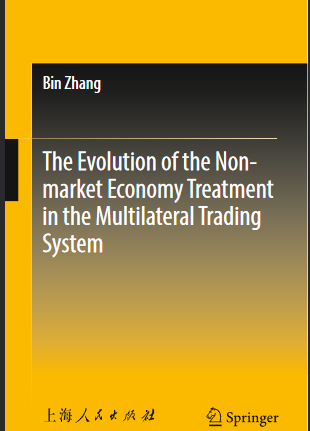The non-market economy (NME) treatment has long been a fundamental issue in the history of the multilateral trading system (MTS), or the GATT/WTO regime. The MTS is an international institution launched by the capitalist superpower after the WWII. Advocating economic liberalism and private ownership of property rights, it has been in conflict with the socialist economic system governed by government planning and public ownership. Meanwhile, as an instrument to con- solidate capitalist powers’ political-economic interests and international position, it has been inevitably antagonist with the socialist bloc politically. Thus, when countries of the two economic systems tried to establish connections through the MTS, those with the planned socialist economic system were deemed to be the opposite of the market-based capitalism, and therefore labeled as “non-market economies”. Consequently, the relationship between the NMEs and the MTS has been a political-economic issue of international significance from the very beginning. With the development of market and non-market economies themselves and of the relationship between them, particularly with the transition of NMEs from planned to market system, the contents of the issue have been evolving and growing. Up to the present, they can be summarized by the following basic questions: From the NMEs’ perspective, what is their attitude towards the MTS? How has their attitude evolved with the change of their domestic institutions? How did their domestic institutional change interact with their accession to the MTS?
چکیده فارسی
رفتار با اقتصاد غیربازار (NME) مدتهاست که یک موضوع اساسی در تاریخ سیستم تجاری چندجانبه (MTS) یا رژیم گات/WTO بوده است. MTS یک نهاد بین المللی است که توسط ابرقدرت سرمایه داری پس از جنگ جهانی دوم راه اندازی شد. با حمایت از لیبرالیسم اقتصادی و مالکیت خصوصی حقوق مالکیت، با سیستم اقتصادی سوسیالیستی که توسط برنامه ریزی دولتی و مالکیت عمومی اداره می شود، در تضاد بوده است. در همین حال، به عنوان ابزاری برای تحکیم منافع سیاسی-اقتصادی و موقعیت بینالمللی قدرتهای سرمایهداری، ناگزیر از نظر سیاسی با بلوک سوسیالیست مخالف بوده است. بنابراین، هنگامی که کشورهای دو نظام اقتصادی سعی کردند از طریق MTS ارتباط برقرار کنند، آنهایی که دارای سیستم اقتصادی سوسیالیستی برنامه ریزی شده بودند، مخالف سرمایه داری مبتنی بر بازار تلقی می شدند و بنابراین به عنوان «اقتصادهای غیربازاری» نامیده می شدند. در نتیجه، رابطه بین NMEs و MTS از همان ابتدا یک موضوع سیاسی-اقتصادی با اهمیت بین المللی بوده است. با توسعه خود اقتصادهای بازاری و غیر بازاری و روابط بین آنها، به ویژه با انتقال NMEها از سیستم برنامه ریزی شده به بازار، محتوای موضوع در حال تحول و رشد بوده است. تا به امروز، آنها را می توان با سؤالات اساسی زیر خلاصه کرد: از دیدگاه NMEs، نگرش آنها نسبت به MTS چیست؟ نگرش آنها با تغییر نهادهای داخلی چگونه تغییر کرده است؟ چگونه تغییر نهادی داخلی آنها با الحاق آنها به MTS تعامل داشت؟
ادامه ...
بستن ...
Author(s): Bin Zhang
Publisher: Springer Singapore, Year: 2018
ISBN: 978-981-13-0652-5,978-981-13-0653-2
ادامه ...
بستن ...










